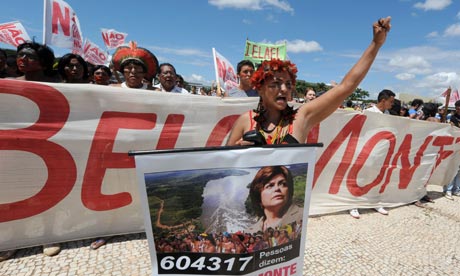OK, so been a bit distracted with many birthday goings on and such in this crazy house, so I'm sorry for falling a wee bit behind!
Anyway, while so far I've investigated how the the on-going fight for space in the Amazon is a very
real, very current threat to the indigenous tribes people of the rainforest,
global warming could possibly pose an even greater, long term threat.
While general circulation models (GCMs) have shown that the most
severe temperature changes due to global warming will occur in the higher
latitudes, Bush and Hooghiemstra (2005)
suggest that the most alarming impacts on biodiversity will occur in the tropics
due to the nature and scale of its diversity and the narrowly restricted niches
these species inhabit.
This is echoed by Cox et al., who use the Hadley Centre climate-carbon cycle GCM (“HadCM3LC" - see picture below for a simplified version of the model) to investigate the possible effects of climate change on Amazonia in the 21st century in terms of temperatures, rainfall and biodiversity.
Simplified graphic of the HadCM3LC by Cox - taken from the University of Exeter course resources.
Cox et al., uses the HadCM3LC for a simple reason. In previous GCMs, the feedback produced by changes in carbon uptake by the biosphere have largely been ignored. In HadCM3LC this is not the case. This model includes increased carbon solubility in seawater and increased biological and terrestrial processes due to temperature increases, and increased photosynthesis and a reduction in transpiration, which are all seen as feedback loops as response to an increase in global levels of carbon dioxide. When taking these feedback loops into account, models have shown an acceleration of carbon dioxide levels - demonstrating carbon levels of 980ppmv by the year 2100 compared to around 700ppmv without.
This large increase in carbon dioxide is largely seen as a result of a decrease in terrestrial carbon stores of 713GtC, which is only ever so slightly offset by an increase in oceanic stores. Therefore, this huge decrease accounts for nearly 280ppmv extra atmospheric carbon.
Differences in regular GCMs and HadCM3LC predictions (Cox et al., 2003)
As you can see from the above graphs, by accounting for carbon feedback loops, terrestrial carbon stores actually cease to be a 'store' and are estimate to become a global land carbon
source due to various mechanisms such as increased decomposition with increasing global temperatures (for more in depth reasons why, please read
Cox's article as it is all explained far better than I ever could).
The results gathered from running the HadCM3LC demonstrate the potential for a devastating effect for the entire world, but in particular, Amazonia. Modelling temperature changes exhibited a large contrast between land and sea temperatures, so although there is seen to be a global warming of 5K average, there would appear to be far more significant warming over terrestrial land areas. This is demonstrated with the temperatures of Western Amazonia estimated to rise by as much as 10K by the 2100, which even goes against my earlier comment from Bush and Hooghiemstra - and this clearly shows the gulf of difference in results between normal GCMs and HadCM3LC. Even more dangerous is this coupling with a decrease in precipitation, with as much as 3mm/day reduction seen.
This stark increase in temperature can only spell trouble for the Amazon rainforest, as temperature increases modelled are outside the optimum for photosynthesis, and this leads to a modelled biomass loss of 8kgCm2. Amazonia is a sensitive place due to the small niches inhabited by its vegetation, but this is warming on an unprecedented scale, and it would suffer even with out such small niches.
Cox et al., go into greater depth about the vegetation changes of Amazonia, but I think I will leave you with this figures for now, as I feel they provide the greatest impact when trying to get across the sheer scale of the effects of climate change on Amazonia. This figures clearly demonstrate the potential disaster the area is facing if carbon increases are left unchecked. However, these are just basic figures and it is impossible to say how the area will definitely respond, let alone how the people of the rainforest will (if at all) be adjust to the inevitable changes that will occur. What I also hope you will take away from this post is the massive uncertainty faced when trying to model the future of our climate, and although you may read articles that sound so sure about their results, small differences in models can produce a vast difference in predictions.
Cox, P.M.,
R. A.
Betts, M.
Collins, P. P.
Harris, C.
Huntingford, C. D.
Jones (2003). Amazonian forest dieback under climate-carbon cycle projections for the 21st century. Theoretical and applied climatology,. 78, 137–156
Bush, M.B. & Hooghiemstra, H. (2005). Tropical biotic responses to climate change. In: Lovejoy, T.E. & Hannah, L. (eds.), Climate Change and Biodiversity. Yale University Press, New Haven & London, pp. 125-137



